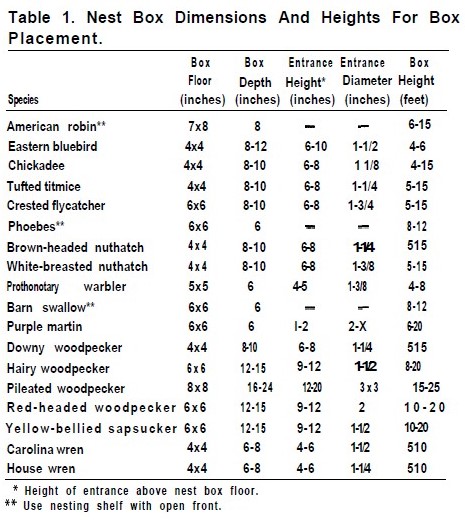Bluebirds, robins, chickadees, titmice, wrens, and purple martins adapt easily to using bird houses. They will choose rural or urban yards alike where there is a small patch of suitable habitat. This may consist of homemade bird houses and berry baskets of hair, moss, cottonballs, and yarn. Or, it may be a patch of wild garden and trees. The birds’ nest building and food gathering provide hours of entertainment to armchair bird watchers.
Nest Box Plans
First, almost any grade of untreated lumber can be used to build nest boxes for any bird species. Several types of wood, however, are more durable and desirable. Treated lumber should never be used for nest boxes. The most durable woods include cypress, cedar, and redwood. You will get much more life out of boxes constructed of these materials. Pine, although less durable, is easier to work and somewhat less expensive than other wood. Exterior-grade plywood can also be used; it is recommended for roof boards, no matter what lumber is used to construct the nest box. Lumber should be at least 3/4 inch thick to provide insulation for the birds. Nest box dimensions and height for placement are shown in the photo.
Painting is usually not necessary, except for purple martin houses or others made of soft wood. Use a waterbased exterior latex if the bird house needs paint. Do not install the box for at least 2 weeks after painting. Light shades of green, gray, and tan are the best choices for nest boxes. Only light colors should be used. Dark colors may cause boxes to overheat and injure eggs and young. Martin condominiums, which are usually placed in open areas, may be painted white to reflect even more light.
Boxes should be ventilated by leaving narrow spaces between the roof and sides or by drilling two 3/8 inch holes in the sides. Drainage holes may be drilled in the floor or 3/8-inch can be cut away from each corner of the floor. Heed this advice and make sure you are using the proper birdhouse dimensions for the bird species in your area.
Nesting baskets can also serve as bird houses for many species. In many urban and suburban areas it is difficult for birds to find nesting materials. Light materials placed in hanging berry baskets will be used readily by yard-nesting songbirds. Attach berry baskets to sturdy limbs with nylon cord. Place them out of reach of cats and dogs. Light materials such as dog hair, moss, cotton balls, yarn, and string can be placed in the baskets, and birds will use them throughout the breeding season.
